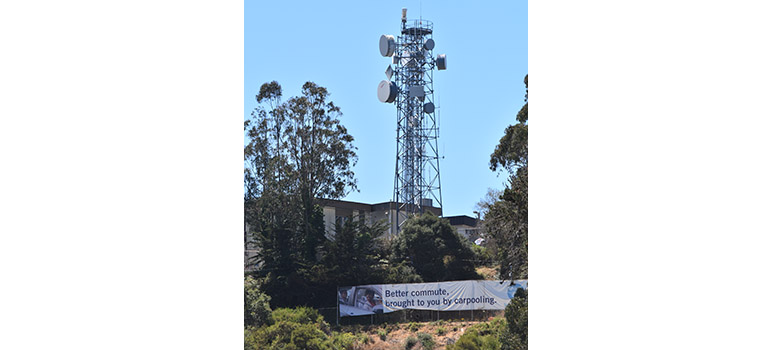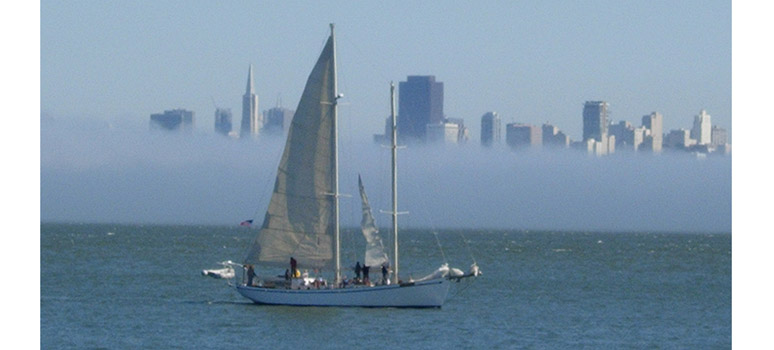The Coast Guard is looking at a plan to reduce costs by defunding the four radar installations in its Vessel Traffic Service (VTS) in and around San Francisco Bay, as well as other radar installations in 11 other major harbors around the country.

Photo by Joel Williams
BY DAN ROSENHEIM
Published: August, 2019
The Coast Guard is looking at a plan to reduce costs by defunding the four radar installations in its Vessel Traffic Service (VTS) in and around San Francisco Bay, as well as other radar installations in 11 other major harbors around the country. The plan was communicated to the Bay Area’s Coast Guard leadership in early March during a surprise visit from headquarters.
At the time, a visiting supervisor from Washington said a decision had been made to defund the radar sites immediately and allow the existing systems to die out and not be replaced. Locally, the move would affect two radar towers in San Pablo Bay, the radar tower at the Coast Guard station on Yerba Buena Island and a fourth radar just outside the Golden Gate at Point Bonita.
Early last month, however, a chance meeting between VTS directors and an admiral attending a national harbor safety conference in Houston convinced the admiral (and ultimately other high-ranking civilians) to support a stay on cutting funds for radar. The VTS directors argued that shutting down radar could have disastrous safety consequences.
“It’s been put on ice,” said Bob Blomerth, VTS Director for the Coast Guard’s Sector San Francisco. “For now, we’ve managed to convince headquarters it’s a bad idea.”
Provided there are adequate funds in the coming year’s Coast Guard budget, the stay would remain in effect through fiscal 2020, which ends September 30 of next year. After that, though, it’s unclear what will happen.
Blomerth and others involved in harbor safety said the proposal to defund radar is driven by the high cost of maintaining an aging system of antennas. In some cases, the original equipment manufacturers have no replacement parts for the current system, which could necessitate a switch to new, more expensive radars—albeit better ones.
“Radar is one of the most expensive parts of the whole surveillance network—both the devices and the upkeep—and Washington has been talking about eliminating it for years,” said one maritime safety expert. “Now there are fears that, with the stroke of a pen, funding could be cut off.”
Most vessels of any size carry their own maritime radar, as well as Automatic Identification Systems (AIS) that use transponders to communicate their location, course and speed. AIS costs far less than radar systems, and it has become an increasingly important traffic safety tool on the water, allowing ships both to see each other and to be seen by the Coast Guard VTS, which monitors all regional maritime traffic from its post on Yerba Buena Island.
But sailors and maritime experts agree that Coast Guard radar provides an important additional layer of protection, particularly for smaller vessels that have limited navigational technology on board. Without its own radar, the Coast Guard will not be able to see boats that don’t have AIS. And while the Coast Guard also has a network of cameras around the Bay that are monitored by VTS, those don’t work in conditions of low visibility.
“We have this thing here called fog,” said Brandon Mercer, a long-time recreational sailor who races sailboats on the Bay. “Vessels that have radar may be able to see each other, but the Coast Guard won’t be able to say, ‘Hey, big ship, you’re about to hit a sailboat.’ Unless the little boat has AIS and has it turned on, the entire burden will be on the big ship.”
Part of the problem is that, while the law requires that vessels of a certain size now carry AIS, it doesn’t apply to all boats, is difficult to enforce and not everyone complies. “There are many, many, many vessels that don’t have AIS,” said Blomerth. But even vessels with AIS may be difficult to track accurately for a variety of reasons, to wit:
-
AIS systems are not always properly maintained; they may not be working properly; and in the event of a power failure or capsize, they may not work at all;
-
As with any GPS system, AIS isn’t always accurate, so a boat’s position as shown on a screen may be 100 yards or more from its actual location;
-
AIS can be turned off, which means that a boat could go rogue for a variety of reasons, including criminal ones, and not be detected. This has potential consequences, not just for the interdiction of smugglers, but also for defense against terrorism.
The threat to defund radar comes after years of essentially flat budgets for the Coast Guard, which was the only branch of the Armed Forces whose members were not paid during the 35-day government shutdown earlier this year. President Trump’s 2020 budget proposal allocates $11.3 billion for the Coast Guard, about $700 million less than was approved by Congress for 2019. These actions, along with the slow rate at which suspended salaries were repaid when the shutdown ended, have rankled some Coast Guard members and civilian employees.
“It just feels like the bureaucrats are steadily paring away at vessel traffic safety,” the maritime safety expert said.
But for Blomerth, the one-year reprieve for radar presents an opportunity. “This is not something we can let sit. Now we have time to get our thoughts together,” he said. “We are going to go for everything. We want to recapitalize and replace the whole existing system.”
Dan Rosenheim is a veteran Bay Area journalist who recently retired after 18 years as Vice President/News for KPIX-5 TV. Prior to going into broadcast, Rosenheim worked as a reporter, city editor and managing editor at the San Francisco Chronicle. Dan and his wife, Cindy Salans Rosenheim, live in San Francisco.

The radar tower located at the Coast Guard station on Yerba Buena Island is one of four Bay Area radar installations targeted for elimination as part of cost-cutting measures. Photo by Joel Williams

Without its own radar, the Coast Guard will not be able to see boats that donít have onboard navigational technology, especially in conditions of low visibility. Photo by Joel Williams

